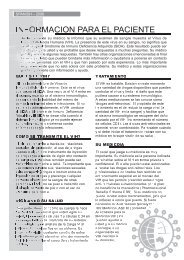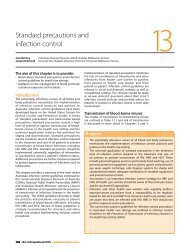HIV, HBV, HCV and STIs: similarities and differences - ASHM
HIV, HBV, HCV and STIs: similarities and differences - ASHM
HIV, HBV, HCV and STIs: similarities and differences - ASHM
Create successful ePaper yourself
Turn your PDF publications into a flip-book with our unique Google optimized e-Paper software.
1 <strong>HIV</strong>, <strong>HBV</strong>, <strong>HCV</strong> <strong>and</strong> <strong>STIs</strong>: <strong>similarities</strong> <strong>and</strong> <strong>differences</strong><br />
Types 16, 18, 31, 33, 35 <strong>and</strong> 45 are high-risk types.<br />
About 50% of invasive squamous cell cancers of<br />
the cervix carry the HPV DNA of type 16. HPV has a<br />
highly significant role in the development of anogenital<br />
cancers whether they be cervical, vulval,<br />
penile or anal cancers. 6 Genital HPV is ubiquitous in<br />
the community; an American study published in 2006<br />
found that in women aged 18 to 25 years, the overall<br />
HPV frequency of detection was 26.9% <strong>and</strong> there was<br />
detectable high-risk HPV DNA in 20% 7 , while another<br />
recent study from a very broad cross-section of the<br />
population in the USA found that the prevalence of<br />
HPV DNA in young women aged 14 to 24 years was<br />
33.8%. 8 Infection usually occurs in adolescence <strong>and</strong><br />
young adulthood soon after the beginning of sexual<br />
activity. Because of the asymptomatic nature of much<br />
HPV genital infection <strong>and</strong> the lack of any specific<br />
antiviral treatment, up until now control of high-risk<br />
HPV type infection in the community has depended<br />
entirely on cervical cancer screening <strong>and</strong> followup<br />
with surgical ablation of high grade squamous<br />
intraepithelial lesions. The recent development <strong>and</strong><br />
licensing in Australia of two prophylactic vaccines<br />
(Gardasil <strong>and</strong> Cervarix) for girls <strong>and</strong> young women<br />
against the commonest high-risk <strong>and</strong> low-risk genital<br />
HPV types is therefore a considerable step forward,<br />
although it should be noted that only one of the<br />
vaccines (Gardasil) is active against HPV types causing<br />
genital warts. 9 Studies of the vaccine in young gay<br />
men will now proceed to inform possible future use<br />
of the vaccine to prevent anal cancer in this group.<br />
Neisseria gonorrhoeae<br />
Neisseria gonorrhoeae, or the gonococcus, the<br />
causative agent of gonorrhoea, is perhaps the best<br />
known sexually transmitted agent <strong>and</strong> has caused<br />
considerable morbidity in human beings since<br />
the earliest recorded history. Gonococci are gramnegative<br />
bacteria which characteristically grow in<br />
pairs as diplococci. Under the light microscope they<br />
are indistinguishable from meningococci <strong>and</strong> indeed<br />
meningococci, on occasions, have been demonstrated<br />
to cause urethritis—hence the need for accurate<br />
microbiological identification of urethral isolates.<br />
Like C. trachomatis, gonococci have a predilection<br />
for the mucous membrane surfaces of the urethra,<br />
endocervical canal, rectum, pharynx <strong>and</strong> conjunctiva.<br />
Sequelae of untreated infections can be serious <strong>and</strong><br />
severe. Some uncommon strains of gonococci cause<br />
little inflammatory response on mucosal surfaces but<br />
have the ability to invade, leading to bacteraemia <strong>and</strong><br />
more systemic disease.<br />
Gonococci possess surface molecules called pili<br />
which are largely responsible for adhesion to mucosal<br />
surfaces <strong>and</strong> also for invasion into the submucosa. Pili<br />
also serve as targets for host defences but have an<br />
amazing ability to undergo swift antigenic change.<br />
This accounts for the almost complete absence of<br />
acquired natural immunity against attacks of mucosal<br />
gonorrhoea. A person can be successfully treated for<br />
14 <strong>HIV</strong>, viral hepatitis <strong>and</strong> <strong>STIs</strong>: a guide for primary care<br />
gonococcal urethritis or cervicitis today <strong>and</strong> if exposed<br />
to infection again tomorrow is completely susceptible<br />
to re-infection. A great deal is known now about the<br />
pathogenicity of N. gonorrhoeae <strong>and</strong> associated hostbacterial<br />
interactions. Despite all this accumulated<br />
knowledge, gonorrhoea remains a considerable<br />
problem around the world. There has been a notable<br />
lack of progress towards vaccine development <strong>and</strong><br />
the gonococcus has an extraordinary capacity to<br />
acquire resistance to antibiotics very rapidly. This<br />
ability continues to present a formidable challenge.<br />
Medical science always seems to be only one step<br />
ahead of this doughty Darwinian survivor. 10<br />
Treponema pallidum<br />
Treponema pallidum is the bacterial agent which<br />
causes syphilis, another well known <strong>and</strong> once feared<br />
STI. T. pallidum is a spirochaetal organism related<br />
to Borrelia <strong>and</strong> Leptospira. It is a long, thin, tightly<br />
coiled bacterium, just beyond the resolution of the<br />
light microscope, although it can be demonstrated<br />
in a microscope with a dark field condenser. Here,<br />
in a wet preparation, it distinguishes itself from<br />
other spirochaetes by its regular tight spirals <strong>and</strong> its<br />
characteristic motility. Both the corkscrew shape <strong>and</strong><br />
the mobility of the organism play important roles in<br />
its invasion <strong>and</strong> dissemination. The body mounts an<br />
immune response against invading treponemes, both<br />
humoral <strong>and</strong> cell-mediated, <strong>and</strong> many of the unique<br />
clinical features of syphilis are due to the immune<br />
response. Bacteria are able to establish latency in<br />
lymphatic <strong>and</strong> splenic tissue <strong>and</strong> during this period<br />
of latency, which may last for many years in untreated<br />
patients, the infected person will be resistant to<br />
reinfection from a new challenge with T. pallidum. 11<br />
Trichomonas vaginalis<br />
Trichomonas vaginalis is a flagellated protozoan which<br />
lives only in the human genitourinary tract. As long<br />
ago as 1836 Donné demonstrated trichomonads as<br />
motile organisms in a preparation of fresh vaginal<br />
discharge, <strong>and</strong> for the next hundred years T. vaginalis<br />
was regarded as a harmless inhabitant of the vagina.<br />
It causes symptomatic infection (vaginitis in women<br />
<strong>and</strong> urethritis in men) but more often is carried<br />
asymptomatically in both sexes. It is highly infectious<br />
<strong>and</strong> almost invariably sexually transmitted. 12<br />
Bacterial vaginosis<br />
Bacterial vaginosis is a common, complex, clinical<br />
syndrome of which the characteristic feature is<br />
an alteration in the normal vaginal flora. Normal<br />
lactobacilli are absent or greatly reduced <strong>and</strong> a swarm<br />
of gram-variable, small, mostly anaerobic microorganisms<br />
including Gardnerella vaginalis, Atopobium<br />
vaginae, Mobiluncus sp, <strong>and</strong> Prevotella sp replace them.<br />
Some of these organisms are highly motile <strong>and</strong> tend<br />
to cluster around shed epithelial cells in vaginal fluid.<br />
Microscopists describe such cells as 'clue cells' <strong>and</strong><br />
they are a hallmark of bacterial vaginosis. The normal






